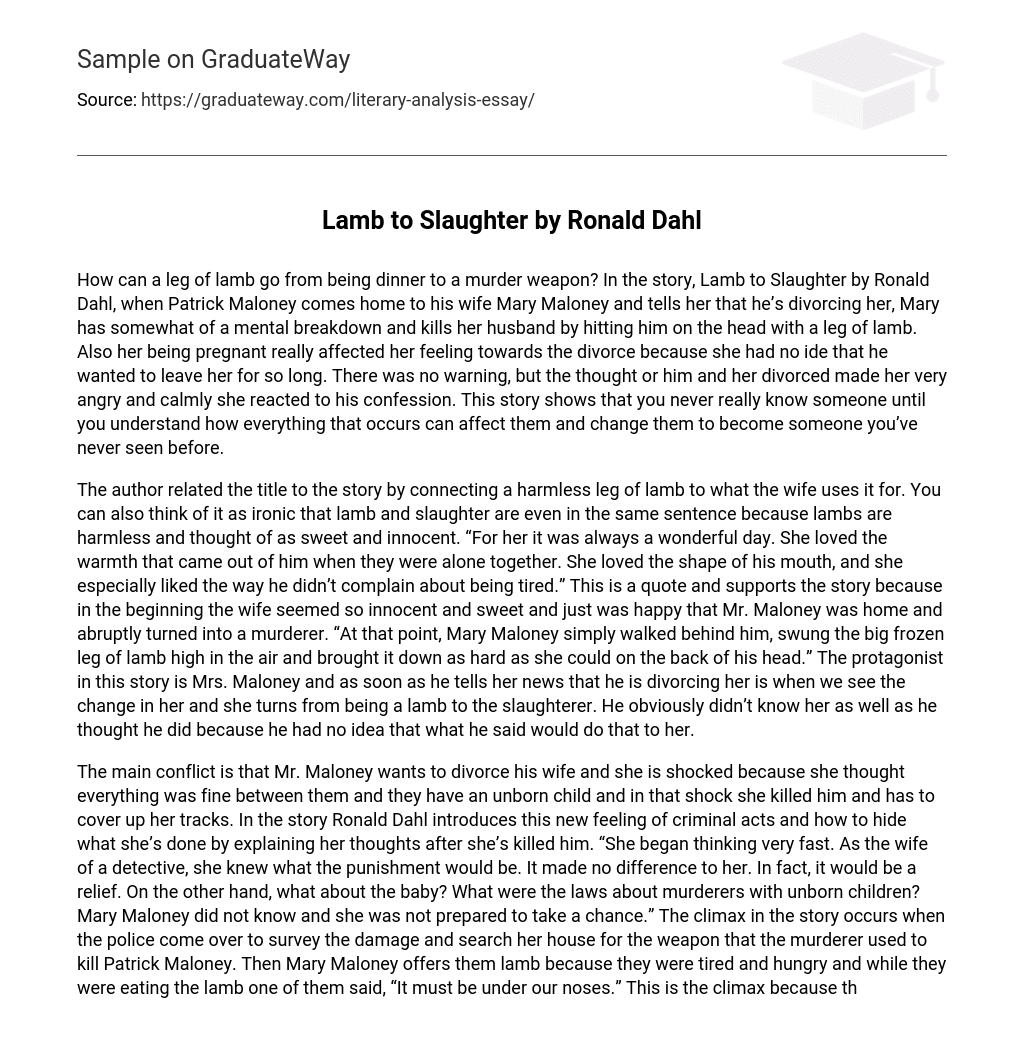In the story “Lamb to Slaughter” by Ronald Dahl, a leg of lamb undergoes a startling transformation from being a dinner item into becoming a lethal murder weapon. Mary Maloney is driven to commit this unthinkable act after hearing her husband Patrick Maloney express his desire to divorce her. Her disturbed state of mind leads her to choose the leg of lamb as her method and she strikes him on the head with it.
Furthermore, the fact that she was pregnant significantly impacted her emotions regarding the divorce as she had no previous knowledge of his intention to separate from her. The lack of warning intensified her anger, yet she managed to respond to his revelation in a composed manner. This narrative underscores the notion that one cannot truly comprehend another individual until they grasp the way in which various experiences can shape and transform them into an unfamiliar entity.
The author establishes a connection between the title and the story by associating a harmless leg of lamb with its intended use by the wife. It can be seen as an ironic juxtaposition, given that lambs are typically perceived as gentle and innocent creatures. The wife considers it a delightful day, relishing the warmth emitted by her husband when they are alone. She admires the shape of his mouth and appreciates his lack of complaint regarding fatigue.
In this passage, the quote emphasizes the wife’s abrupt change from being innocent and sweet to becoming a killer, which is crucial to the story. It depicts how Mary Maloney, the protagonist, surprisingly attacks her husband with a frozen leg of lamb after he reveals his plan to divorce her. This revelation drastically transforms Mrs. Maloney from being gentle to merciless. It becomes evident that the husband lacked comprehension of his wife since he didn’t anticipate such an extreme response from her.
In this text, the central conflict revolves around Mr. Maloney’s intention to divorce his wife, which comes as a surprise to her since she believed their relationship was strong. The situation becomes more complex due to their pregnancy. In her state of shock, she resorts to killing him and now faces the challenge of concealing her actions. Ronald Dahl explores this unfamiliarity with committing a crime and the subsequent need for secrecy by delving into her post-act contemplations. “She rapidly begins pondering possible courses of action, fully aware that there could be severe repercussions for her as the spouse of a detective. Nonetheless, these potential penalties hold no significance in her mind.”
In fact, it would be a relief but what about the baby and the laws regarding murderers with unborn children? Mary Maloney was unaware of these laws and unwilling to take any risks. The story reaches its climax when the police visit her home to investigate the crime scene and search for the murder weapon used to kill Patrick Maloney. Mary Maloney decides to offer them lamb to eat, as they were tired and hungry. While they were enjoying the meal, one of the police officers remarked, “It must be right under our noses.”
This passage represents the climax point in the story. It emphasizes the possibility that the murderer’s weapon could be right in front of the characters, as they were unknowingly eating the murder weapon. This situation highlights the theme of deception and how well one can truly know another person. It reveals Mr. Maloney’s ignorance regarding Mary Maloney’s intelligence and cunning, and how her knowledge as a detective aided her in concealing his death.
The story is narrated in the third person perspective, referring to characters as “he,” “she,” and “they.” For example, the narrator states, “A few minutes later she got up and went to the phone. She knew the number of the police station.” The author uses different literary techniques including symbolism, dramatic irony, verbal irony, and situational irony. In this story, the leg of lamb serves as a symbol representing the shift from innocence or kindness to becoming a murderer or a murder weapon.
The text showcases dramatic irony as the audience is aware that the leg of lamb serves as the murder weapon, and Mrs. Maloney feeds it to the cops to dispose of the evidence. However, the cops remain oblivious to this fact. “Personally, I think the weapon is somewhere near the house. It’s probably under our noses. And in the other room, Mary Maloney began to laugh.” Another form of irony, verbal irony, occurs when the grocer asks Mrs. Maloney if she wants meat and she responds, “No, I’ve got meat, thanks, and I’ve got a nice leg of lamb, from the freezer.” This phrase is verbally ironic because it implies that she already has meat, while indirectly referring to the leg of lamb she used to kill her husband.
Situational irony occurs when the police, who were meant to search her house for the murder weapon, unintentionally consume it. This situation is linked to the core idea of comprehending someone else’s true nature. Because of her husband’s connection with law enforcement, she has formed a bond with them gradually. They trust in her innocence and would go to any lengths for Patrick. Yet unbeknownst to them, she conceals a sinister side that they have never seen.
In conclusion, the situation could have been approached differently in terms of delivering negative information. Instead of informing his wife in a non-caring and disrespectful manner, Mr. Maloney could have chosen to deliver the news in a gentler, more caring, and careful way. By doing so, he might still be alive and they could have gone through a civil divorce while continuing to live together as two individuals. This instance serves as an evident example of how a normal person can react negatively when bad news is conveyed in an insensitive manner. Despite being a nice and good woman who did not intend any harm, the wife was understandably disturbed by the information she received.





